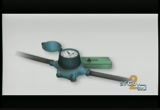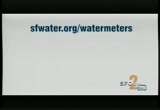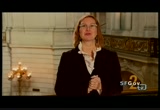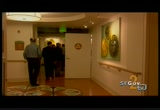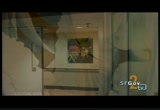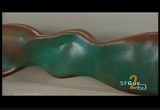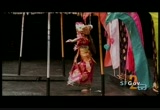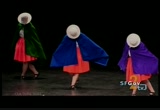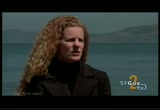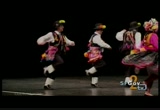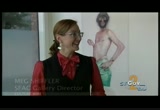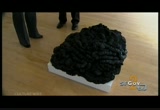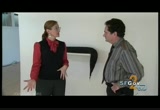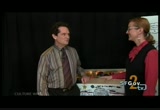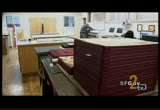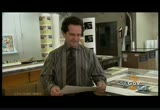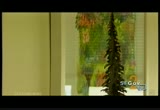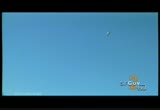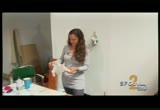tv [untitled] July 20, 2011 9:30pm-10:00pm PDT
9:32 pm
significant public art projects today. ♪ on june 26, mayor newsom and other officials gathered at the hospital to cut the ribbon and welcome the public into a beautiful new state-of-the-art facility. >> 3, 2, 1. [applause] >> in has been 10 years since voters approved the measure for the new building. >> when they cast the vote, we have an exciting opportunities to rethink how art is done in a hospital setting. >> replacement program generated
9:33 pm
approximately $3.9 million in art enrichment funds for a comprehensive art program that contributes to the quality of life at the hospital by enhancing the environment and supporting the hospital's needs and therapeutic goals. artists were commissioned to create 100 original works of art. as was for the gardens and courtyard areas. >> be artwork does more than just hang on the wall. it will enhance the therapeutics of the hospital and will include sensory stimulation, orientation, social interaction. >> it was set into like boxes to create color filled areas in the
9:34 pm
hospital. inspired by nature, the signature painting of native san francisco birds, clouds, and the surface of the ocean waves were translated into a variety of media including glass mosaic and tapestry. the playful clock encourages memory stimulation among the patients. they used the theme of the four elements as they relate to vocation. it is a direct homage to the historical murals in the original laguna honda building. it features to large tile walls. by observing residents, the
9:35 pm
gardens created a public artwork in the form of the handrail. in one of the outdoor courtyards, the circular grouping of -- with a smooth finish. this features ten unique button sculptures with different pastel colors that function not only as a place to sit, but also as a touchstone to something recognizable, familiar, and comforting. another key component included an art project that responded directly to the hospital's rich history. using archival images and artifacts, had designed 16 intricately woven tapestries
9:36 pm
that are inviting of significant events that shaped the hospital and the community over time. a >> it attracts a lot of visitors, and they are all and all - -in aw -- in awe over the variety of mediums used. >> i think we have given the city of san francisco and the residents an incredible art collection. it really encourage people to come and visit the new facility, also to see the arts. >> for more information, visit sfartscommis
9:37 pm
>> the san francisco ethnic dance festival is one of the jewels on san francisco sculptural crowns. this is in its 32nd year of showcasing the celebrated dance troupes. this year will be one of the past with four new works representing kondo, afghanistan, china, mexico. -- congo, afghanistan, china, mexico. more than a hundred 30 ensembles and soloists auditioned in january for a slot in the ethnic dance festival. in the end, 37 companies were selected to perform.
9:38 pm
26 of those performances are world premieres. >> each year, we assembled a panel of dance experts that is made up of academics, scholars, researchers. people have been working for decades in the field. many of them came to this country in the seventies and have trained the next generation of dancers. they are proud to see many of these students at the these masterful levels. this was one of the best panel'' we have ever had, extraordinary people. at the end of the process, they rank their top groups which are then merged into a master list. >> performers are judged on stage presence, costumes, and
9:39 pm
innovation. >> the four programs are created around an exciting and dynamic range so the soloists and groups selected each weekend will have enough dynamic range to be a society overall to are experience. >> hundreds of dancers from different countries need each other, compare stuff, and make new friends. this has resulted in new cross- cultural collaborations'. >> one of the extraordinary things is that it really only happens here in the san francisco bay area. all of the dancers that we are presented -- presenting are from the area. they have full-time jobs and they spend their weekends
9:40 pm
nurturing their passion to sustain these extraordinary dance forms from around the world. the audience cannot help but be inspired. >> this year, the festival will feature a special collaboration that celebrates the mexican bicentennial and commemorates the 100th anniversary of the mexican revolution. >> one of the great area biographers has stepped out of that role and we asked them to create a special work working with 6 x ordinary dance companies that we have assembled dancers from all of these companies to present a united work in celebration of the bicentennial. >> dancers from over 20 countries are staunch cultures are participating.
9:41 pm
>> one of the things that is inspiring is how many are being invited back to their home countries as cultural ambassadors from the u.s.. we are teaching them in committees so that the next generation here in america and back to india or bali or whatever will be able to get enriched by these very beautiful art forms. >> thank you for watching "culture wire." and you can find more information >> i'm your host of "culturewire," and today, here
9:42 pm
at electric works in san francisco. nice to see you today. thanks for inviting us in and showing us your amazing facility today. >> my pleasure. >> how long has electric works been around? >> electric works has been in san francisco since the beginning of 2007. we moved here from brisbane from our old innovation. we do printmaking, gallery shows, and we have a fabulous retail store where there are lots of fun things to find. >> we will look at all of that as we walk around. it is incredible to me how many different things you do. how is it you identify that san francisco was in need of all these different services? >> it came from stepping out of graduate school in 1972. i wrote a little thing about how this is an idea, how our world should work. it should have printmaking, archiving, a gallery.
9:43 pm
it should have a retail store. in 1972, i wanted to have art sales, point-of-sale at the grocery store. >> so you go through the manifesto. with the bay area should have. you are making art incredibly accessible in so many different ways, so that is a good segue. let's take a walk around the facilities. here we are in your gallery space. can you tell me about the current show? >> the current show is jeff chadsey. he is working on mylar velum, a smooth, beautiful drawing surface. i do not know anyone that draws as well as he does. it is perfect, following the contours and making the shape of the body. >> your gallery represents artists from all over, not just
9:44 pm
the bay area, an artist that work in a lot of different media. how to use some of what you look for in artists you represent? >> it is dependent on people are confident with their materials. that is a really important thing. there is enough stuff in the world already. >> you also have in his current show an artist who makes sculpture out of some really interesting types of materials. let's go over and take a look at that. here we are in a smaller space. project gallery. >> artists used the parameters of this space to find relationships between the work that is not out in the big gallery. >> i noticed a lot of artists doing really site-specific work. >> this is a pile of balloons, something that is so familiar, like a child's balloon. in this proportion, suddenly, it becomes something out of a
9:45 pm
dream. >> or a nightmare. >> may be a nightmare. >> this one over here is even harder to figure out what the initial material is. >> this is made out of puffy paint. often, kids use it to decorate their clothes. she has made all these lines of paint. >> for the pieces we are looking at, is there a core of foam or something in the middle of these pieces that she built on top of? >> i'm not telling. >> ah, a secret. >> this silver is aluminum foil, crumbled of aluminum foil. her aesthetic is very much that quiet, japanese spatial thing that i really admire. their attention to the materiality of the things of the world. >> this is a nice juxtaposition you have going on right now. you have a more established
9:46 pm
artists alongside and emerging artists. is that something important to you as well? >> very important in this space, to have artists who really have not shown much. now let's look at other aspects of electric works operation. let's go to the bookstore. >> ok. >> in all seriousness, here we are in your store. this is the first space you encounter when you come in off the street. it has evolved since you open here into the most amazingly curious selection of things. >> this was the project for the berkeley art museum. it was -- this is from william wiley's retrospective, when he got up onstage to sing a song, 270 people put on the cat. >> it is not just a bookstore. it is a store. can you talk us through some of your favorites? >> these are made in china, but
9:47 pm
they are made out of cattails. >> these pieces of here, you have a whale head and various animals and their health over there, and they are jewelry. >> we do fund raisers for nonprofits, so we are doing a project for the magic theater, so there are some pretty funny cartoons. they are probably not for prime time. >> you sort of have a kind of holistic relationship where you might do merchandise in the store that promotes their work and practice, and also, prince for them. maybe we should go back and look at the print operation now. >> let's go. >> before we go into the print shop, i noticed some incredible items you have talked back here. what are we standing in front of? >> this is william wiley, only
9:48 pm
one earth. this is a print edition. there are only eight total, and what we wanted to do was expand the idea of printmaking. this is really an art object. there we go. >> besides the punball machine, what do you produce in limited edition? >> there is the slot machine. if you win the super jackpot, you have saved the world. >> what about work? >> the right design, it was three volumes with lithographs in each volume. the cab of count dracula with 20 lithographs inside and lined with beaver fur. really special.
9:49 pm
>> let's move on to the print shop. >> ok. the core of what we do is making things. this is an example. this is a print project that will be a fund-raiser for the contemporary music players. we decided to put it in the portfolio so you could either frame at or have it on your bookshelf. >> so nonprofits can come to you, not just visual are nonprofits, but just nonprofits can come to you, and you will produce prints for them to sell, and the profits, they can keep. >> the return on investment is usually four times to 10 times the amount of investment. this is for the bio reserve in mexico, and this is one of the artists we represent. >> you also make prints for the artists that you represent. over here are some large prints by a phenomenal artist.
9:50 pm
>> he writes these beautiful things. anyone who has told you paradise is a book of rules is -- has only appeared through the windows. this is from all over coffee. we are contract printers for all kinds of organizations all across the country. >> thank you very much for showing us around today. i really appreciate you taking the time to let me get better acquainted with the operation and also to share with our "culturewire" team. >> welcome to "culturewire." today we are at recology. they are celebrate 20 years of
9:51 pm
one of the most incredibly unique artist residency programs. we are here to learn more from one of the resident artists. welcome to the show, deborah. tell us how this program began 20 years ago. >> the program began 20 years ago. our founder was an environmentalist and an activist and an artist in the 1970's. she started these street sweeping campaigns in the city. she started with kids. they had an exhibition at city hall. city officials heard about her efforts and they invited her to this facility. we thought it would coincide with our efforts to get folks to recycle, it is a great educational tool. since then, we have had 95 professional artists come through. >> how has the program changed over the years? how has the program -- what can
9:52 pm
the public has an artist engage with? >> for the most part, we worked with metal and wood, what you would expect from a program like ours. over the years, we tried to include artists and all types of mediums. conceptual artists, at installation, photographers, videographers. >> that has really expanded the program out. it is becoming so dynamic right now with your vision of interesting artists in gauging here. why would an artist when to come here? >> mainly, access to the materials. we also give them a lot of support. when they start, it is an empty studio. they go out to the public area and -- we call it the big store. they go out shopping, take the materials that, and get to work. it is kind of like a reprieve, so they can really focus on
9:53 pm
their body of work. >> when you are talking about recology, do you have the only sculpture garden at the top? >> it is based on work that was done many years ago in new york. it is the only kind of structured, artist program. weit is beautiful. a lot of the plants you see were pulled out of the garbage, and we use our compost to transplant them. the pathway is lined with rubble from the earthquake from the freeways we tour about 5000 people a year to our facility, adults and children. we talk about recycling and conservation. they can meet the artists. >> fantastic. let's go meet some of your current artists. here we are with lauren.
9:54 pm
can you tell us how long have been here so far and what you're working on? >> we started our residency on june 1, so we came into the studio then and spent most of the first couple weeks just digging around in the trash. i am continuing my body of work, kind of making these hand- embroidered objects from our day-to-day life. >> can you describe some of the things you have been making here? this is amazing. >> i think i started a lot of my work about the qualities of light is in the weight. i have been thinking a lot about things floating through the air. it is also very windy down here. there is a piece of sheet music up there that i have embroidered third. there is a pamphlet about hearing dea -- nearing death. this is a dead rabbit.
9:55 pm
this is what i am working on now. this is a greeting card that i found, making it embroidered. it is for a very special friend. >> while we were looking at this, i glanced down and this is amazing, and it is on top of a book, it is ridiculous and amazing. >> i am interested in the serendipity of these still life compositions. when he got to the garbage and to see the arrangement of objects that is completely spontaneous. it is probably one of the least thought of compositions. people are getting rid of this stuff. it holds no real value to them, because they're disposing of it. >> we're here in another recology studio with abel. what attracted you to apply for this special program? >> who would not want to come to the dump? but is the first question. for me, being in a situation
9:56 pm
that you're not comfortable in has always been the best. >> what materials were you immediately attracted to when you started and so what was available here? >> there are a lot of books. that is one of the thing that hits me the most. books are good for understanding, language, and art in general. also being a graphic designer, going straight to the magazines and seeing all this printed material being discarded has also been part of my work. of course, always wood or any kind of plastic form or anything like that. >> job mr. some of the pieces you have made while you have been here. -- taught me through some of the pieces you have made while you have been here. >> the first thing that attracted me to this was the printed surface. it was actually a poster. it was a silk screen watercolor, about 8 feet long. in terms of the flatwork, i work with a lot of cloddish. so being able to cut into it
9:57 pm
come at into it, removed parts, it is part of the process of negotiating the final form. >> how do you jump from the two dimensional work that you create to the three-dimensional? maybe going back from the 3f to 2d. >> everything is in the process of becoming. things are never said or settled. the sculptures are being made while i am doing the collages, and vice versa. it becomes a part of something else. there's always this figuring out of where things belong or where they could parapets something else. at the end goal is to possibly see one of these collage plans be built out and create a structure that reflects back into the flat work. >> thank you so much for allowing "culturewire" to visit this amazing facility and to
9:58 pm
learn more about the artists in residence program. is there anything you like our viewers to know? >> we have art exhibitions every four months, and a win by the public to come out. everybody is welcome to come out. we have food. sometimes we have gains and bands. it is great time. from june to september, we accept applications from bay area artists. we encouraged artists from all mediums to apply. we want as many artists from the bay area out here so they can have the same experience. >> how many artists to do your host here? >> 6 artist a year, and we receive about 108 applications. very competitive. >> but everyone should be encouraged to apply. thank you again for hosting us. >> thank you for including us in "culturewire." ♪
62 Views
IN COLLECTIONS
SFGTV2: San Francisco Government Television Television Archive
Television Archive  Television Archive News Search Service
Television Archive News Search Service 
Uploaded by TV Archive on

 Live Music Archive
Live Music Archive Librivox Free Audio
Librivox Free Audio Metropolitan Museum
Metropolitan Museum Cleveland Museum of Art
Cleveland Museum of Art Internet Arcade
Internet Arcade Console Living Room
Console Living Room Books to Borrow
Books to Borrow Open Library
Open Library TV News
TV News Understanding 9/11
Understanding 9/11